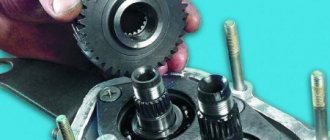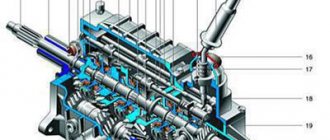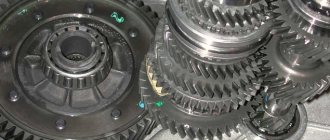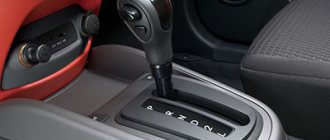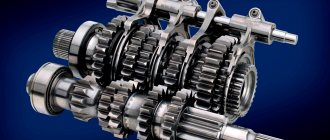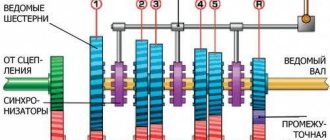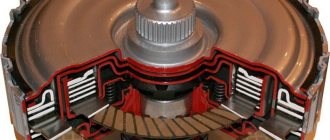Purpose of the sixth gear of the gearbox for a VAZ
There is an opinion that 6th gear is needed exclusively for moving on the highway, that is, we enjoy the absence of engine roar at high speeds.
Others see other advantages in this, such as faster, more dynamic and smooth acceleration, while maintaining maximum speed. And still others are trying to reduce gasoline consumption by installing a sixth gear in a VAZ. Despite a number of advantages of 6-speed over 5-speed, there are also opponents of such modification of the gearbox. They argue that there is no point in doing such tuning if there is a standard engine under the hood. In any case, whether to install 6th gear or not is up to you, but here is the approximate price tag:
Buy a 6th gear kit for VAZ 2108..2110
| Previously, cars were equipped with 4-speed gearboxes and at that time this was quite enough. Currently, the requirements have changed, and the speeds are completely different, which is why many modern foreign cars have a six-speed gearbox. Is it possible to install sixth gear on a VAZ of the tenth family and what will it change? |
| In online stores you can find many kits, including for the standard range of gearboxes. The approximate cost is 13 thousand rubles. |
Technical characteristics of the VAZ 2170 gearbox
| Type | Mechanics |
| Number of gears | 5 |
| For drive | front |
| Engine capacity | up to 1.8 liters |
| Torque | up to 170 Nm |
| What kind of oil to pour | Lukoil TM-4 75W-90 GL-4 |
| Lubricant volume | 3.5 liters |
| Change of oil | once every 75,000 km |
| Replacing the filter | every 75,000 km |
| Approximate resource | 160,000 km |
Disadvantages, breakdowns and problems of the Lada Priora box
Most often, owners complain about howling transmissions and rattling manual transmission knobs.
Drivers are also annoyed by unclear shifting and poor lever locking
Many oil seals begin to leak oil even at low mileage of the car.
The gearbox control drive and clutch require periodic adjustment
Synchronizers, bearings and gears wear out quite quickly here
You can contact the site administrator by email: [email protected]
All texts were written by me, are authored by Google, included in the original Yandex texts and notarized. For any borrowing, we immediately write an official letter on company letterhead in support of search networks, your hosting and domain registrar.
Next we go to court. Don’t try your luck, we have more than thirty successful Internet projects and have already won a dozen lawsuits.
Gearbox – gearbox. Transmissions can be mechanical, robotic, CVT, or automatic. The VAZ 2114 2113 2115 is equipped with a 5-speed manual transmission with a rocker drive. In principle, the box remained from the same “eight”, but with a different main pair.
Extending service life
- Follow the sequence of speed changes and make all shifts smoothly, without jerking.
- When switching between first and second gear, maintain short one-second pauses.
- A preventive examination will help detect and eliminate defects.
- To maintain the functionality of the fifth gear, it is recommended to fill the gearbox oil above the maximum mark. To prevent leaks (air locks), oil is poured in 100 ml portions. Sometimes another oil seal is added to the rocker to prevent leaks.
- The gearbox oil 2114 should be changed after 60-80 thousand kilometers.
Main couple
The main pair is the main shaft of the box (main gear). The main pair serves to reduce the speed transmitted from the engine. On average, the main pair reduces the number of revolutions by 4 times: the engine spins 4 thousand. rpm - main pair 1 thousand. rpm The main pair as standard has a gear ratio: 3.7. By changing the main pair, you can significantly change the dynamics of the car. Depending on the size of the main pair, you can change the length of all gears, hence the maximum speed and acceleration. (By the way, the nine has a 3.9 main pair, due to this it has a lower maximum speed, but is faster at acceleration).
Classification by structure
Volkswagen Passat Das graue Auto Logbook Replacing the gear shift cable
According to the structure, car gearboxes are divided into the following types: two-shaft and three-shaft. Both have their own advantages and features.
Twin-shaft box: device and principle of operation
The drive shaft of such boxes guarantees connection with the clutch. The driven shaft has a parallel arrangement and contains a gear block. If necessary, the differential helps provide different angular speeds.
Mechanism
Communication can be provided through special cables and rods. The simplest option is cables. It is the most common and convenient for experienced drivers and beginners.
The operating mechanism of this device is similar to the principle of a three-shaft gearbox, the main difference lies in the gear shifting features. The division of the lever, when the gear is engaged, is carried out in the longitudinal and transverse directions. Gear selection occurs through the functioning of all elements and their interaction.
Three-shaft manual transmission
The structure contains a drive shaft and a driven shaft, both contain synchronizers with gears and a switching mechanism. The drive shaft provides connection between the mechanisms and the clutch system. Parallel to it there is an intermediate shaft, which includes gears in the block.
The mechanism responsible for switching is located on the body. Its design includes a control lever and sliders equipped with forks. To prevent both gears from operating simultaneously, remote control is provided.
Principle of operation
This type of gearbox does not involve transmitting torque to the front wheels. The consequence of movement of the control lever is movement of the clutch. As a result, thanks to the clutch, speed synchronization is ensured.
Gear ratios (row)
Gear ratios are the gears of each gear, which also have their own size.
Gear ratios characterize the speed characteristics of a car in a particular gear. In a standard VAZ, the following numbers are used:
3,636
1,95
1,357
0,941
0,784
3,53
The characteristics shown above are just with standard gear ratios.
The standard range on the 2114 is far from ideal: First gear is too short – second gear is too long. Due to this, there is a sharp drop in dynamics when switching from first to second. Not only is there a failure, but when switching sharply, the second gear synchronizer slowly dies.
Therefore, there are sports series where the gap between 1st and 2nd is removed, and not only: sports series are selected according to the type of engine: it can just be a good city engine, or a sports one, or tailored for 402-meter racing. There are also “turbo” gears - designed for a turbo engine.
Installing the sixth speed gear
Installation instructions and execution procedure:
- Take a standard set of tools for removing and disassembling the box and the tool described above
- It is necessary to follow all procedures and take safety measures as when removing the box
- Removing the gearbox (see VAZ 2109 gearbox repair: how to do it correctly) according to all the rules with an assistant
- Disassemble the box up to and including removing the housing from it.
Box disassembled before removing the case
- We replace the rod for the 5th speed fork with the rod of the 5th-6th speed
- Screw the housing back
- If it was not possible to immediately install the 5th gear gears of the secondary shaft due to lack of space for the needle bearing, then take a grinder and grind either the bearing or the spacer ring (grind down one millimeter)
- Then we put the lower retaining ring of the synchronizer hub on the bushing of our secondary shaft
- Then we insert the spacer ring we ground off from below, press the bushing onto the secondary shaft (you may need to use a hammer in this case)
- When disassembling, most likely, it will be necessary to sacrifice the synchronizer hub; it will hardly be possible to compress it without damaging it
- Insert the 5th gear needle bearing
- Then install the spacer ring for the 5th speed gear
- We insert the 5th speed gear together with the gear block of the 5th-6th speeds of the input shaft
- Then we install the block. Ring for 5th gear synchronizer
- Next, we install our synchronizer (from the former 5th gear) on the synchronizer hub for first and second gears.
- We press the hub complete (assembled) with the fork and coupling onto the bushing from the secondary shaft until the fork is screwed to the rod
- We put on the second locking ring
- Installing the block
- Then the 6th speed synchronizer ring
- We push the 6th speed gear of the secondary shaft into its place, to do this we lift the 5th-6th gear block of the primary shaft
- This is done without a bearing, because otherwise it simply won’t fit.
- If this manipulation fails, you will have to assemble the 5th-6th speed unit in your hands
- The 6th gear needle bearing can then be inserted
- Engage 2nd gear using the rod
- We turn on the 5th gear with our hands, without turning off the second
- Using a 12mm hex wrench, tighten the input shaft nut
- Then we make a mark for the M6 bolt on the nut opposite the hole in the 5th-6th speed unit
- Unscrew the nut back
- We make a special fixing hole on it, use a grinder for this (it will be clear to you where exactly)
- We reduce the height of the head of the bolt from the RTD so that it no longer touches the bearing
- Be sure to lubricate all the shaft nuts with Loctite, then tighten them
- We tighten the fixing bolt with M6 thread
- We press the internal parts from the roller bearings onto the shaft nuts
- Press the remaining bearing parts into the box lid
- We replace two studs in the gearbox housing with purchased ones
- We put on the lid. It will touch the steel plate
- Therefore, when installing it, we will have to grind the cover with a drill and a cutter
Gearbox configurations
Below are the most successful gearbox configurations depending on the engine. For a more detailed selection, you can use a calculator on the Internet.
- The most suitable gearbox configuration for a civilian naturally aspirated engine: 18 row gearbox + main pair 3.9.
- The most suitable gearbox for a sports naturally aspirated engine: 7 row gearbox + main pair 4.3.
- The most suitable gearbox configuration for a turbo civilian engine: row 104 + main pair 3.5.
The differential is two-satellite, the tension is adjusted by different thicknesses of the adjusting ring.
Sports cars often use a differential lock.
A differential lock is a mechanism that locks the differential so that both wheels rotate evenly. Initially, locking was used on SUVs to ensure that the front and rear axles rotated evenly.
In our case, screw locks are especially popular, because... are easily installed in the gearbox, increase cross-country ability on wet roads, and provide an advantage during acceleration due to uniform constant rotation of the wheels.
Backstage
On modern cars, including the new Grants, Kalinas, and Priors, gearboxes with cable-driven gears are installed, thanks to which gear shifting becomes easy and precise. In Samara: 2114 -2113-2115 the gear drive is carried out not by a cable, but by a rocker.
The slide is a development from the 80s, so the gears may not engage the first time, may not engage well, etc.
On sports tuned cars they often install a “short-throw” rocker.
The essence of the short-throw shifter is that the path of the gearshift lever from neutral to gear becomes shorter than it was. Simply put: the gears are easier to engage, the lever travel is shorter - which gives a significant advantage when shifting.
Review of the gearbox
VAZ front-wheel drive gearboxes have the same problems. They all howl and make noise; the gears have significant play between them, which causes jerking when releasing the gas while moving in gear. As mentioned above, the first gear is too short, and the second is too long, which causes failure during acceleration and increases wear. Installing a different row of gears may solve the problem of failure, but all sports rows have more noise during operation than a regular gearbox, which is not particularly quiet in operation anyway.
Advantages of the 4-speed option
Gearboxes
Many drivers praise the common four-speed gearboxes and do not trust the newfangled six-speed automatic transmission. They make the following arguments:
- Unreliability. Four stages are better because they have been invented a long time ago and are more reliable, and automatic transmissions with a large number of gears will break down more often.
- Money spendings. Firstly, the six-speed gearbox itself is more expensive than a four-speed gearbox. Secondly, its repair will require additional costs, since the automatic transmission mechanism there is more complicated, and in combination with the first point, the six-speed gearbox generally becomes a huge hole in the budget of the owner of a car with such a transmission.
- No differences. Also, supporters of the four-speed automatic transmission claim that there are no differences in driving sensations with different automatic transmissions, and they do not see the difference at all. Moreover, in their opinion, there are no differences in the technical part: fuel consumption, speed, smoothness of switching.
However, one should not draw hasty conclusions, since all these arguments are erroneous. A six-speed automatic transmission is far from a new item in the automotive industry, and all the errors (which may have occurred in the first generations of cars with such gearboxes) have long been corrected. The designs of these boxes are very similar, which means it is impossible to judge which automatic transmission is more reliable and practical - most likely, they are the same in this parameter.
